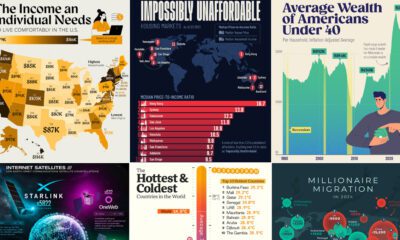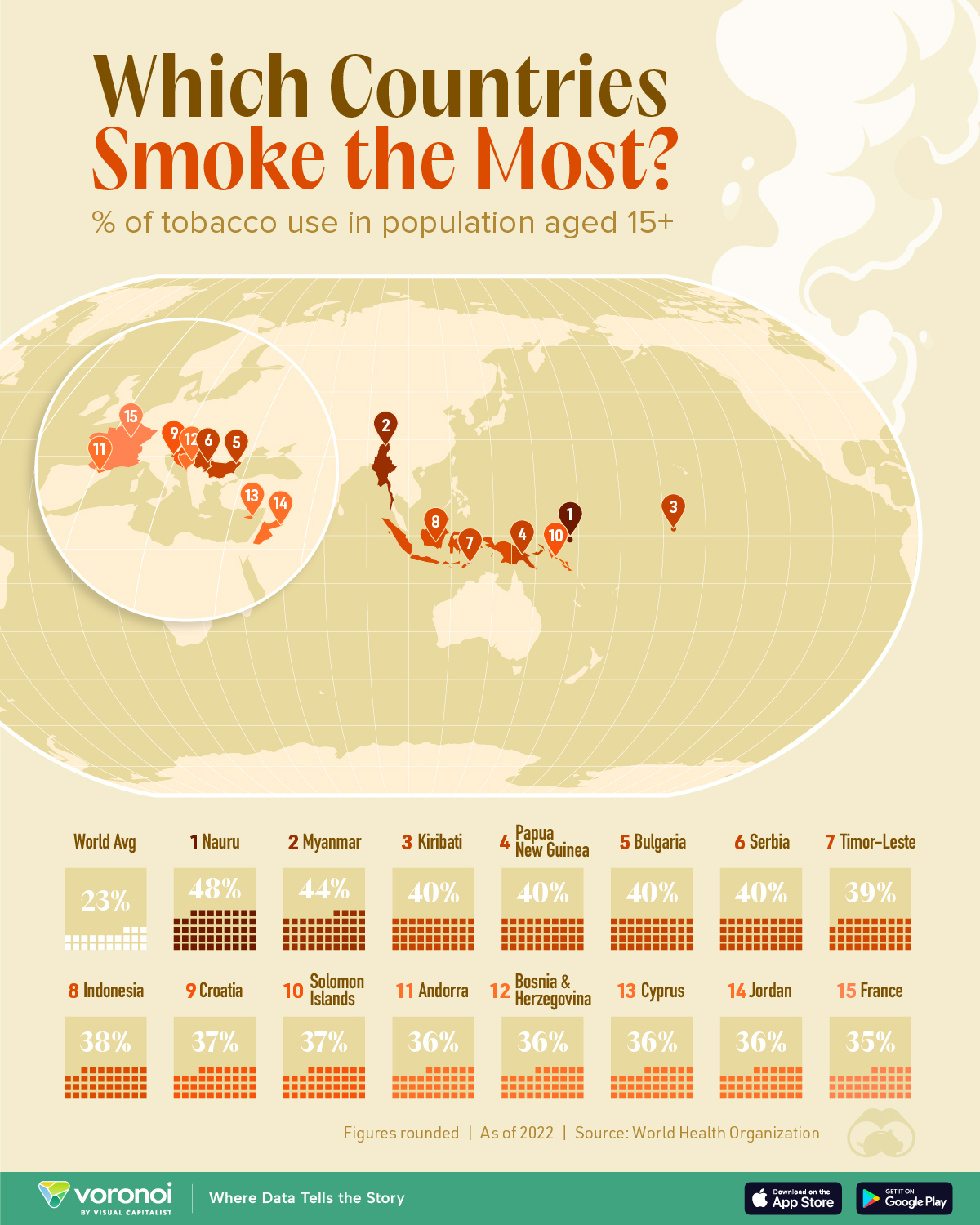Healthcare
Mapped: Abortion Legality by U.S. State
![]() See this visualization first on the Voronoi app.
See this visualization first on the Voronoi app.
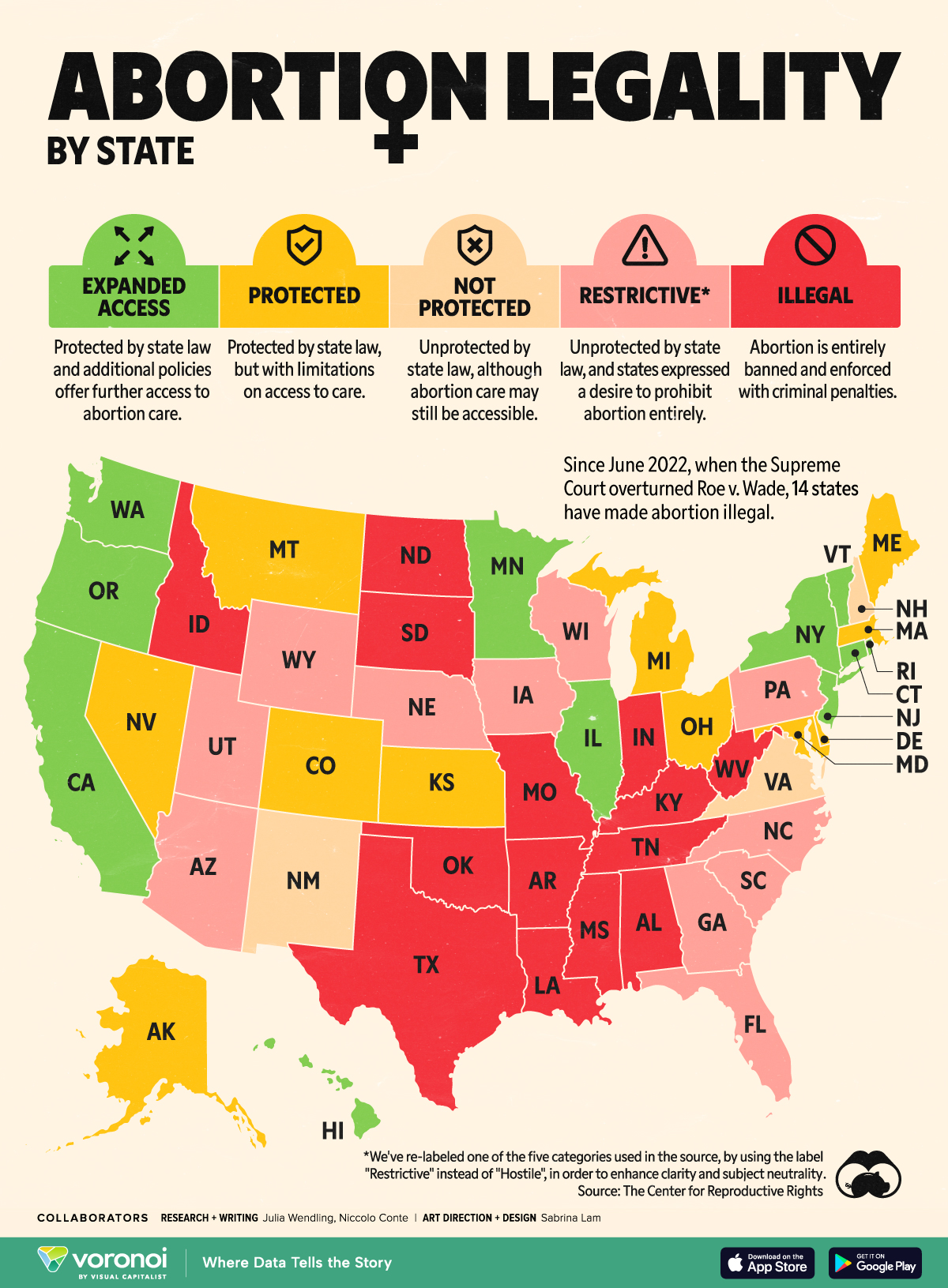
Abortion Legality in America by State
This was originally posted on our Voronoi app. Download the app for free on iOS or Android and discover incredible data-driven charts from a variety of trusted sources.
In June 2022, the U.S. Supreme Court overturned Roe v. Wade, opening the door for states to make their own decisions regarding abortion legality.
In this graphic, we visualize how each U.S. state has altered abortion legality in the post-Roe era, using data from the Center for Reproductive Rights.
What Is Roe v. Wade?
Roe v. Wade refers to the landmark ruling by the Supreme Court in 1973 that dictated that the Constitution of the United States protected an individual’s right to have an abortion.
For over 50 years, the ruling prevented states from banning or significantly restricting abortion to their populations.
As of June 2022, this is no longer the case, as five Supreme Court justices voted to overturn Roe, while four supported maintaining it.
What Happened After Roe Was Overturned?
Since the June 2022 ruling, 14 states—including Texas, Missouri, and much of the South—have made abortion illegal.
| State | Abortion Legality Status |
|---|---|
| Alabama | Illegal |
| Alaska | Protected |
| Arizona | Restrictive |
| Arkansas | Illegal |
| California | Expanded Access |
| Colorado | Protected |
| Connecticut | Expanded Access |
| Delaware | Protected |
| Florida | Restrictive |
| Georgia | Restrictive |
| Hawaii | Expanded Access |
| Idaho | Illegal |
| Illinois | Expanded Access |
| Indiana | Illegal |
| Iowa | Restrictive |
| Kansas | Protected |
| Kentucky | Illegal |
| Louisiana | Illegal |
| Maine | Protected |
| Maryland | Protected |
| Massachusetts | Protected |
| Michigan | Protected |
| Minnesota | Expanded Access |
| Mississippi | Illegal |
| Missouri | Illegal |
| Montana | Protected |
| Nebraska | Restrictive |
| Nevada | Protected |
| New Hampshire | Not Protected |
| New Jersey | Expanded Access |
| New Mexico | Not Protected |
| New York | Expanded Access |
| North Carolina | Restrictive |
| North Dakota | Illegal |
| Ohio | Protected |
| Oklahoma | Illegal |
| Oregon | Expanded Access |
| Pennsylvania | Restrictive |
| Rhode Island | Expanded Access |
| South Carolina | Restrictive |
| South Dakota | Illegal |
| Tennessee | Illegal |
| Texas | Illegal |
| Utah | Restrictive |
| Vermont | Expanded Access |
| Virginia | Not Protected |
| Washington | Expanded Access |
| West Virginia | Illegal |
| Wisconsin | Restrictive |
| Wyoming | Restrictive |
Views on abortion in another 11 states are considered “restrictive,” meaning the states have indicated a desire to ban abortion and have no protections in place. Large variability, however, exists among these states. For example, Florida has restricted abortion after 6 weeks, except in cases where the woman’s life is at risk, whereas Arizona has restricted abortion after 15 weeks.
Conversely, 11 states—predominantly located on the East and West coasts—have moved to increase access to abortions and associated care in the wake of the decision to overturn Roe. Again, variability among this group exists. Oregon and New York have no restrictions based on gestation time. California and Hawaii restrict abortion access at fetal viability (24-26 weeks). Also, states in the “expanded access” category tend to have a higher concentration of abortion clinics, making care more readily accessible.
An additional 11 states have opted to protect abortions rights, though some gestational limitations may still exist. For instance, Kansas has restricted abortions after 22 weeks, but a statewide referendum in August 2022 upheld the right to abortion.
Abortion is accessible to varying degrees in the remaining states, but no specific protections are in place.
Abortion Legality Worldwide
While abortion is legal in many developed countries, it remains prohibited or highly restricted in several others, including the U.S., Poland, Malta, and Ireland.
The U.S. is also one of the few countries to have rolled back abortion laws in the last 30 years. The country is joined by Poland, Nicaragua, and El Salvador who have also tightened abortion legality.
In contrast, over the last three decades, over 60 countries have moved to expand abortion access. As a result, 60% of women who are of reproductive age—totaling 1.12 billion—live in regions where abortion is broadly legal.
See More Graphics about Healthcare
If you found this interesting, check out this visualization on life expectancy trends in the United States.
Maps
Mapped: 15 Countries with the Highest Smoking Rates
Since the 1950s, many countries have tried to discourage tobacco use and bring down smoking rates. Here’s where they haven’t worked.
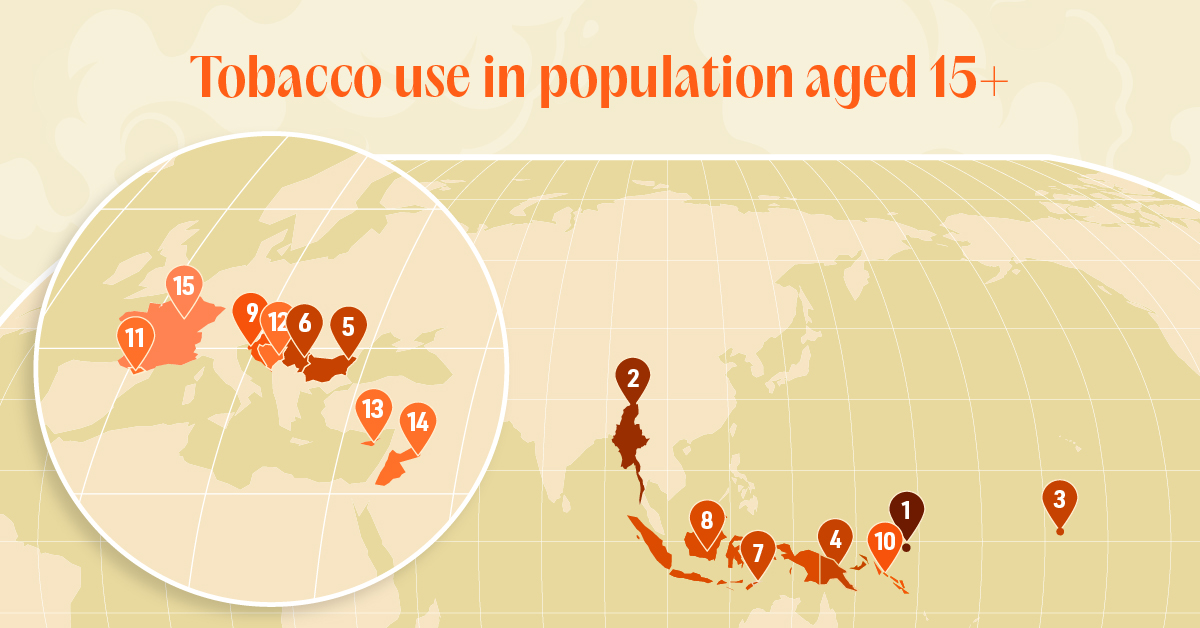
Mapped: 15 Countries with the Highest Smoking Rates
This was originally posted on our Voronoi app. Download the app for free on iOS or Android and discover incredible data-driven charts from a variety of trusted sources.
It was not until 1950 when the link between smoking and lung cancer was proven, though physicians as far back as the late 19th century had identified it as a potential cause.
Since then, many countries have discouraged tobacco products in an attempt to reduce smoking rates, and consequent health effects.
We visualize the countries with the highest rates of tobacco use among their population aged 15 and older. Data is sourced from the World Health Organization, and is current up to 2022.
Which Countries Smoke the Most?
In Nauru, nearly half of the population aged 15+ uses a tobacco product, the highest in the world. The island also has a high obesity rate, and nearly one-third of the population suffers from diabetes, due to poor nutritional variety in the food supply.
Here’s a list of smoking rates by country, ranked from highest to lowest.
| Rank | Country | Tobacco use in those aged 15+ |
|---|---|---|
| 1 | 🇳🇷 Nauru | 48% |
| 2 | 🇲🇲 Myanmar | 44% |
| 3 | 🇰🇮 Kiribati | 40% |
| 4 | 🇵🇬 Papua New Guinea | 40% |
| 5 | 🇧🇬 Bulgaria | 40% |
| 6 | 🇷🇸 Serbia | 40% |
| 7 | 🇹🇱 Timor-Leste | 39% |
| 8 | 🇮🇩 Indonesia | 38% |
| 9 | 🇭🇷 Croatia | 37% |
| 10 | 🇸🇧 Solomon Islands | 37% |
| 11 | 🇦🇩 Andorra | 36% |
| 12 | 🇧🇦 Bosnia & Herzegovina | 36% |
| 13 | 🇨🇾 Cyprus | 36% |
| 14 | 🇯🇴 Jordan | 36% |
| 15 | 🇫🇷 France | 35% |
| N/A | 🌍 World | 23% |
Note: Figures rounded. “Tobacco use” includes smoke and smokeless products.
Meanwhile, countries in the Balkan also see a high incidence of tobacco use, bucking the general European trend. Entrenched cultural norms, lax laws, and inexpensive cigarettes are some of the most commonly identified causes.
On the other hand, tobacco use is a lot lower in the Americas and sub-Saharan Africa.
In the U.S., fewer than one in four adults smoke. Canada is even lower at 12% of the population. But some African countries (Nigeria and Ghana) are all the way down in the single-digits, at 3%.
Interestingly, men smoke more than women in nearly every country in the world.
-

 Markets2 weeks ago
Markets2 weeks agoThe Growth of $100 Invested in Jim Simons’ Medallion Fund
-

 Misc1 week ago
Misc1 week agoChart: Which Countries Eat the Most Instant Noodles?
-

 Misc1 week ago
Misc1 week agoRanked: The 10 Highest-Grossing Concert Tours of All Time
-

 Maps1 week ago
Maps1 week agoCharted: Unauthorized Immigrants in the U.S., by Country of Origin
-

 Misc1 week ago
Misc1 week agoRanked: The Top 10 U.S. Pizza Chains by Market Share
-
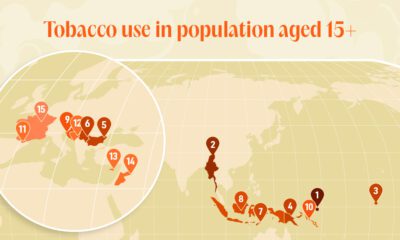
 Maps1 week ago
Maps1 week agoMapped: 15 Countries with the Highest Smoking Rates
-

 Markets1 week ago
Markets1 week agoRanked: Which NHL Team Takes Home the Most Revenue?
-
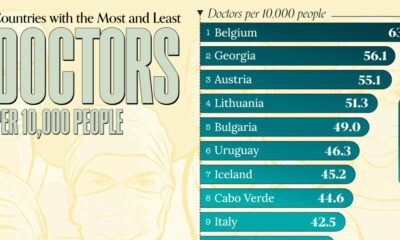
 Maps2 weeks ago
Maps2 weeks agoMapped: Highest and Lowest Doctor Density Around the World

